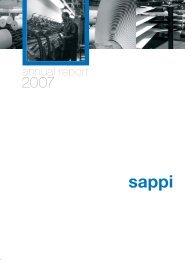2012 Integrated report - Sappi
2012 Integrated report - Sappi
2012 Integrated report - Sappi
Create successful ePaper yourself
Turn your PDF publications into a flip-book with our unique Google optimized e-Paper software.
Governance and compensation continued<br />
Top risks<br />
Risk philosophy<br />
We have a coordinated risk management approach and methodology to manage, coordinate and execute the risk management<br />
process throughout <strong>Sappi</strong>.<br />
Complete risk assessments are conducted at least annually in our divisions and for the group, and are updated every six months.<br />
The process uses our strategy as the base against which to assess risk scenarios. The scope of the risk assessment includes risks<br />
that may lead to a significant cost, liability or loss, including loss of opportunity, or may affect the current strategic plan. These risks<br />
are identified and analysed, and risk responses to each individual risk are designed, planned, implemented and monitored.<br />
Risk<br />
1. We operate in a cyclical<br />
industry. Global economic<br />
conditions may cause<br />
substantial fluctuations in<br />
our results.<br />
Risk description and treatment<br />
Our pulp and paper products are significantly affected by cyclical changes in industry capacity and<br />
output levels and by the impact on demand from changes in the world economy. As a result of supply<br />
and demand imbalances in the pulp and paper industry, these markets historically have been cyclical,<br />
with volatile pulp and paper prices. In addition, recent turmoil in the world economy has led to sharp<br />
reductions in volume and pressure on prices in many of our markets and we acted rapidly to match our<br />
output to demand by curtailing pulp production at Tugela and Enstra Mills. We took actions to improve<br />
efficiencies and reduce costs in all aspects of our business. We continue to maintain a high level of<br />
economic pulp integration on a groupwide basis which reduces the impact of pulp price fluctuations on<br />
our results. We will continue to monitor the supply/demand balance which might require us to impair<br />
operating assets and/or implement further capacity closures.<br />
2. The markets for pulp,<br />
dissolving wood pulp and<br />
paper products are highly<br />
competitive.<br />
There has been a recent trend towards consolidation in the pulp, dissolving pulp and paper industries<br />
creating larger, more focused companies. The dissolving wood pulp capacity conversions at our<br />
Ngodwana and Cloquet Mills to increase our market share and strengthen our leading position in the<br />
speclialised cellulose market are on track. We also continue to drive good customer service, innovation<br />
and efficient manufacturing and logistics. We are focused on improving the performance and<br />
competitiveness of our European business, in particular of coated mechanical paper. We are also taking<br />
steps to improve the performance of our Southern African paper and paper packaging business.<br />
3. We require significant<br />
amounts of finance to fund<br />
our business and our ability<br />
to generate cash or borrow<br />
depends on many factors,<br />
some of which are beyond<br />
our control.<br />
Our ability to fund our working capital, capital expenditure, research and development requirements and<br />
to make payments on our debt principally depends on cash available from our credit facilities, other<br />
debt arrangements and our operating performance. Our year end cash balance as well as our debt<br />
maturity profile provide us with adequate headroom to fund our short term requirements. We are also<br />
focusing on profit improvement in our operations by reducing fixed and variable costs, spending capital<br />
prudently and managing working capital levels.<br />
4. Fluctuations in the value of<br />
currencies, particularly the<br />
Rand and the Euro, in<br />
relation to the US Dollar,<br />
have in the past had and<br />
could in the future have a<br />
significant impact on our<br />
earnings in these<br />
currencies.<br />
<strong>Sappi</strong> is exposed to economic, transaction and translation currency risks. The objective of the group in<br />
managing transactional currency risks is to ensure that foreign exchange exposures are identified as<br />
early as possible and actively managed. In managing transactional currency risks, the group first makes<br />
use of internal hedging techniques (hedging to the functional currency of the entity concerned) with<br />
external hedging being applied thereafter. External hedging techniques consist primarily of foreign<br />
forward exchange contracts and currency options. Foreign currency capital expenditure on projects is<br />
covered as soon as practical (subject to regulatory approval).<br />
92
















